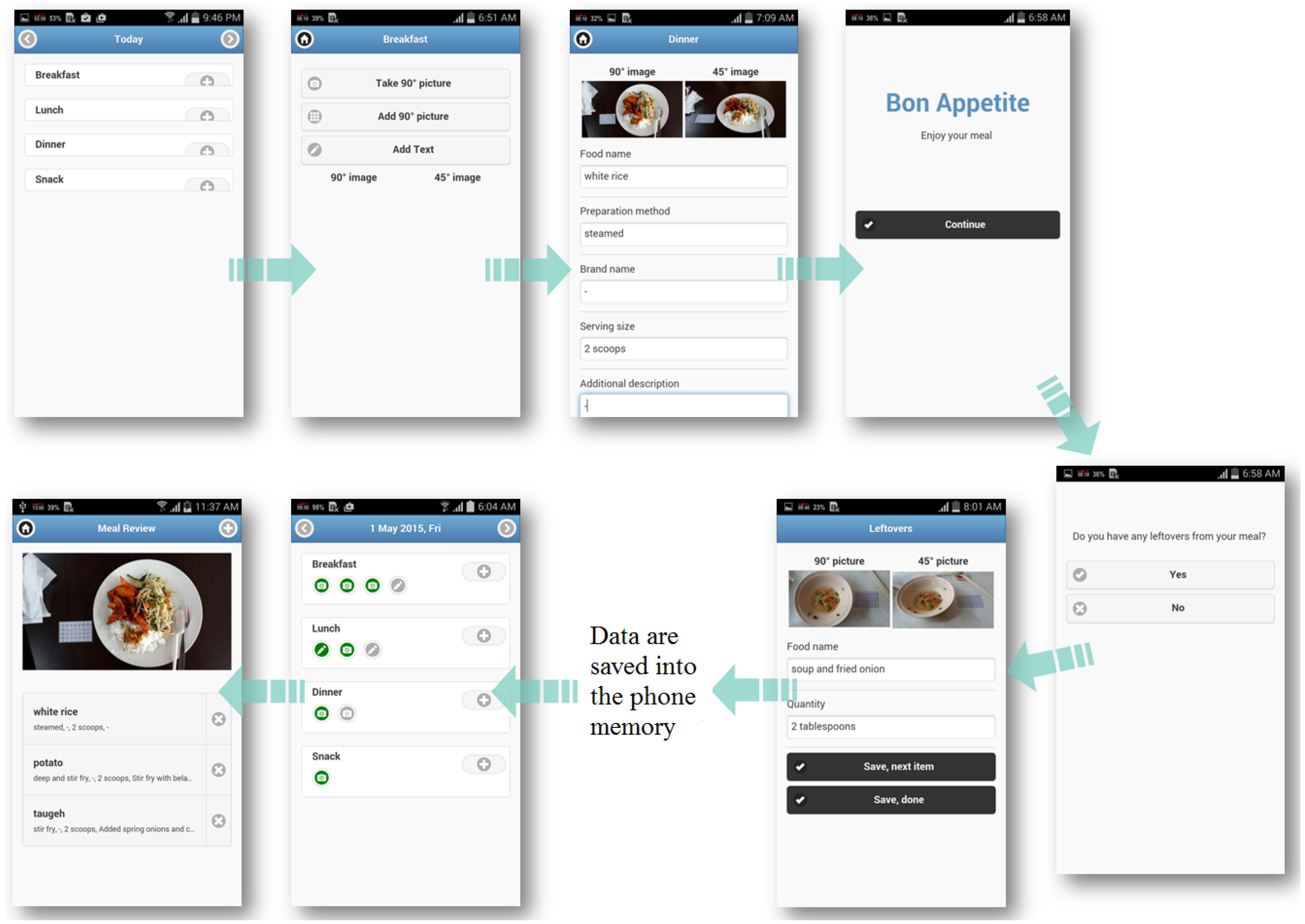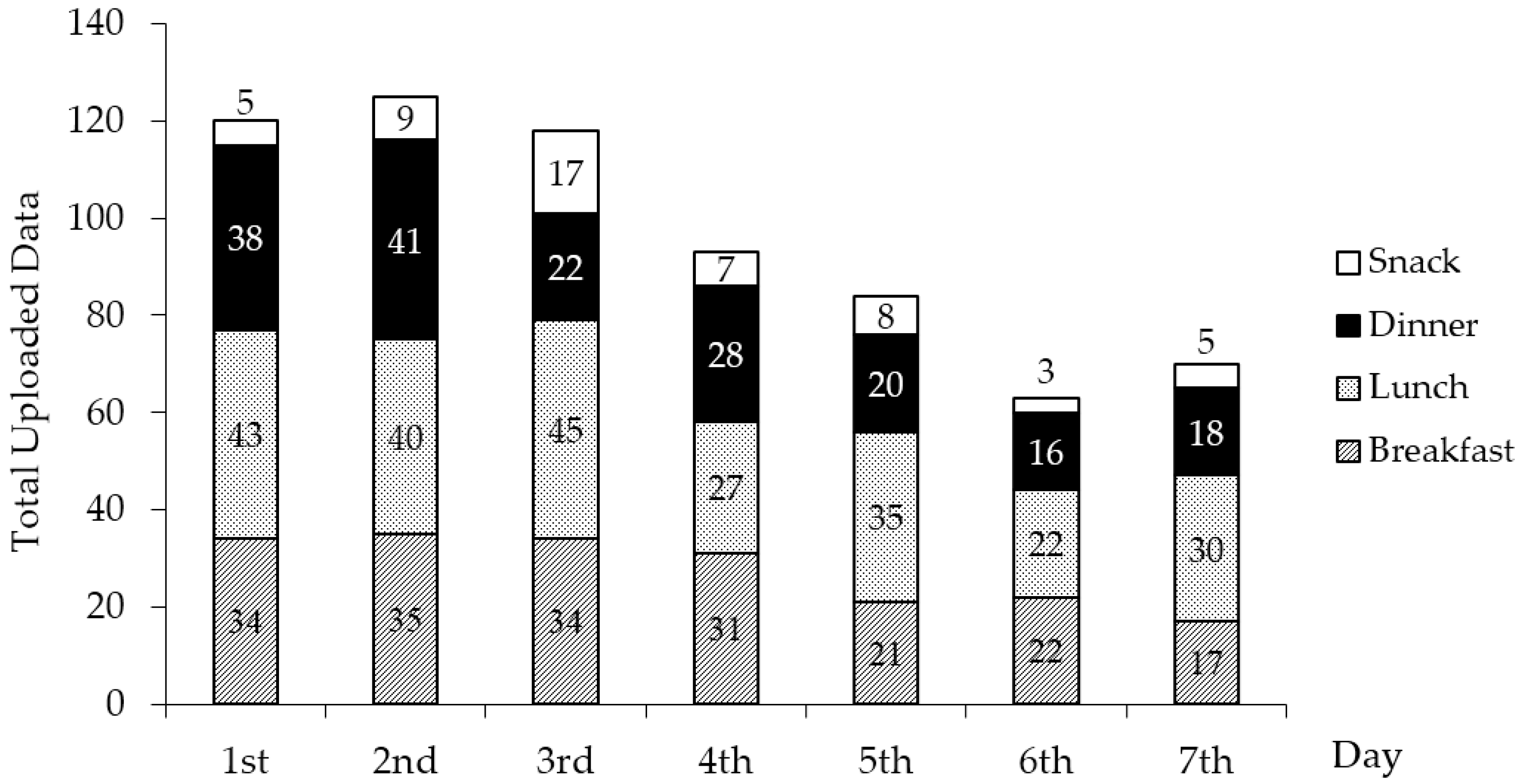Can Malaysian Young Adults Report Dietary Intake Using a Food Diary Mobile Application? A Pilot Study on Acceptability and Compliance
Abstract
:1. Introduction
2. Materials and Methods
2.1. Dietary Reporting Using the Food App
2.2. Focus Group Discussion
2.3. Compliance and Acceptability Evaluation
3. Results
3.1. Compliance in Dietary Reporting
3.2. Acceptability in Dietary Reporting
3.3. Focus Group Discussions
3.3.1. Theme 1: Features of the Food App
3.3.2. Theme 2: Potential Use of the Food App
3.3.3. Theme 3: Utility Issues
3.3.4. Theme 4: Suggestions for Improvements
4. Discussion
5. Conclusions
Acknowledgments
Author Contributions
Conflicts of Interest
References
- Rahman, M.H.; Li, Q.; Pickering, M.; Frater, M.; Kerr, D.; Bouchey, C.; Delp, E. Food volume estimation in a mobile phone based dietary assessment system. In Proceedings of the 2012 Eighth International Conference on Signal Image Technology and Internet Based Systems, Naples, Italy, 25–29 November 2012; pp. 988–995.
- Six, B.L.; Schap, T.E.; Zhu, F.M.; Mariappan, A.; Bosch, M.; Delp, E.J.; Ebert, D.S.; Kerr, D.A.; Boushey, C.J. Evidence-based development of a mobile telephone food record. J. Am. Diet. Assoc. 2010, 110, 74–79. [Google Scholar] [CrossRef] [PubMed]
- Zhu, F.; Bosch, M.; Woo, I.; Kim, S.; Boushey, C.J.; Ebert, D.S.; Delp, E.J. The use of mobile devices in aiding dietary assessment and evaluation. IEEE J. Sel. Top. Signal Process. 2010, 4, 756–766. [Google Scholar] [PubMed]
- Thompson, F.E.; Subar, A.F.; Loria, C.M.; Reedy, J.L.; Baranowski, T. Need for technological innovation in dietary assessment. J. Am. Diet. Assoc. 2010, 110, 48–51. [Google Scholar] [CrossRef] [PubMed]
- Guinn, C.H.; Baxter, S.D.; Hardin, J.W.; Royer, J.A.; Smith, A.F. Intrusions in children’s dietary recalls: The roles of BMI, sex, race, interview protocol, and social desirability. Obesity 2008, 16, 2169–2174. [Google Scholar] [CrossRef] [PubMed]
- Livingstone, M.B.; Robson, P.J.; Wallace, J.M. Issues in dietary intake assessment of children and adolescents. Br. J. Nutr. 2004, 92 (Suppl. 2), S213–S222. [Google Scholar] [CrossRef] [PubMed]
- Burke, L.E.; Warziski, M.; Starrett, T.; Choo, J.; Music, E.; Sereika, S.; Stark, S.; Sevick, M.A. Self-monitoring dietary intake: Current and future practices. J. Ren. Nutr. 2005, 15, 281–290. [Google Scholar] [CrossRef] [PubMed]
- Haller, G.; Haller, D.M.; Courvoisier, D.S.; Lovis, C. Handheld vs. Laptop computers for electronic data collection in clinical research: A crossover randomized trial. J. Am. Med. Inform. Assoc. 2009, 16, 651–659. [Google Scholar] [CrossRef] [PubMed]
- Favé, G.; Beckmann, M.; Draper, J.; Mathers, J.C. Measurement of dietary exposure: A challenging problem which may be overcome thanks to metabolomics? Genes Nutr. 2009, 4, 135–141. [Google Scholar] [CrossRef] [PubMed]
- Jabs, J.; Devine, C.M. Time scarcity and food choices: An overview. Appetite 2006, 47, 196–204. [Google Scholar] [CrossRef] [PubMed]
- Nelson, M.C.; Story, M.; Larson, N.I.; Neumark-Sztainer, D.; Lytle, L.A. Emerging adulthood and college-aged youth: An overlooked age for weight-related behavior change. Obesity 2008, 16, 2205–2211. [Google Scholar] [CrossRef] [PubMed]
- Boushey, C.J.; Kerr, D.A.; Wright, J.; Lutes, K.D.; Ebert, D.S.; Delp, E.J. Use of technology in children’s dietary assessment. Eur. J. Clin. Nutr. 2009, 63 (Suppl. 1), S50–S57. [Google Scholar] [CrossRef] [PubMed]
- Daugherty, B.L.; Schap, T.E.; Ettienne-Gittens, R.; Zhu, F.M.; Bosch, M.; Delp, E.J.; Ebert, D.S.; Kerr, D.A.; Boushey, C.J. Novel technologies for assessing dietary intake: Evaluating the usability of a mobile telephone food record among adults and adolescents. J. Med. Internet Res. 2012, 14, e58. [Google Scholar] [CrossRef] [PubMed]
- Casperson, S.L.; Sieling, J.; Moon, J.; Johnson, L.; Roemmich, J.N.; Whigham, L. A mobile phone food record app to digitally capture dietary intake for adolescents in a free-living environment: Usability study. JMIR mHealth uHealth 2015, 3, e30. [Google Scholar] [CrossRef] [PubMed]
- Schap, T.E.; Zhu, F.; Delp, E.J.; Boushey, C.J. Merging dietary assessment with the adolescent lifestyle. J. Hum. Nutr. Diet. 2014, 27 (Suppl. 1), 82–88. [Google Scholar] [CrossRef] [PubMed]
- Lazarte, C.E.; Encinas, M.E.; Alegre, C.; Granfeldt, Y. Validation of digital photographs, as a tool in 24-h recall, for the improvement of dietary assessment among rural populations in developing countries. Nutr. J. 2012, 11, 61. [Google Scholar] [CrossRef] [PubMed]
- Krueger, R.A.; Casey, M.A. Designing and conducting focus group interviews. Soc. Anal. Sel. Tools Tech. 2001, 36, 4–23. [Google Scholar]
- Ritchie, J.; Lewis, J. Qualitative Research Practice: A Guide for Social Science Students and Researchers; Sage: Thousand Oaks, CA, USA, 2003. [Google Scholar]
- Davis, F.D. Perceived usefulness, perceived ease of use, and user acceptance of information technology. MIS Q. 1989, 13, 319–340. [Google Scholar] [CrossRef]
- Akturan, U.; Tezcan, N. Mobile banking adoption of the youth market. Mark. Intell. Plan. 2012, 30, 444–459. [Google Scholar] [CrossRef]
- Ho Cheong, J.; Park, M.C. Mobile internet acceptance in korea. Internet Res. 2005, 15, 125–140. [Google Scholar] [CrossRef]
- Holden, R.J.; Karsh, B.T. The technology acceptance model: Its past and its future in health care. J. Biomed. Inf. 2010, 43, 159–172. [Google Scholar] [CrossRef] [PubMed]
- López-Nicolás, C.; Molina-Castillo, F.J.; Bouwman, H. An assessment of advanced mobile services acceptance: Contributions from tam and diffusion theory models. Inf. Manag. 2008, 45, 359–364. [Google Scholar] [CrossRef]
- Mun, Y.Y.; Jackson, J.D.; Park, J.S.; Probst, J.C. Understanding information technology acceptance by individual professionals: Toward an integrative view. Inf. Manag. 2006, 43, 350–363. [Google Scholar]
- Adamson, A.; Baranowski, T. Developing technological solutions for dietary assessment in children and young people. J. Hum. Nutr. Diet. 2014, 27, 1–4. [Google Scholar] [CrossRef] [PubMed]
- Wang, D.H.; Kogashiwa, M.; Ohta, S.; Kira, S. Validity and reliability of a dietary assessment method: The application of a digital camera with a mobile phone card attachment. J. Nutr. Sci. Vitaminol. 2002, 48, 498–504. [Google Scholar] [CrossRef] [PubMed]
- Hongu, N.; Pope, B.T.; Bilgic, P.; Orr, B.J.; Suzuki, A.; Kim, A.S.; Merchant, N.C.; Roe, D.J. Usability of a smartphone food picture app for assisting 24-h dietary recall: A pilot study. Nutr. Res. Pract. 2015, 9, 207–212. [Google Scholar] [CrossRef] [PubMed]
- Hutchesson, M.J.; Rollo, M.E.; Callister, R.; Collins, C.E. Self-monitoring of dietary intake by young women: Online food records completed on computer or smartphone are as accurate as paper-based food records but more acceptable. J. Acad. Nutr. Diet. 2015, 115, 87–94. [Google Scholar] [CrossRef] [PubMed]
- Boushey, C.J.; Harray, A.J.; Kerr, D.A.; Schap, T.E.; Paterson, S.; Aflague, T.; Bosch Ruiz, M.; Ahmad, Z.; Delp, E.J. How willing are adolescents to record their dietary intake? The mobile food record. JMIR mHealth uHealth 2015, 3, e47. [Google Scholar] [CrossRef] [PubMed]
- Aizawa, K.; Maeda, K.; Ogawa, M.; Sato, Y.; Kasamatsu, M.; Waki, K.; Takimoto, H. Comparative study of the routine daily usability of foodlog: A smartphone-based food recording tool assisted by image retrieval. J. Diabetes Sci. Technol. 2014, 8, 203–208. [Google Scholar] [CrossRef] [PubMed]
- Rebro, S.M.; Patterson, R.E.; Kristal, A.R.; Cheney, C.L. The effect of keeping food records on eating patterns. J. Am. Diet. Assoc. 1998, 98, 1163–1165. [Google Scholar] [CrossRef]
- Hebden, L.; Cook, A.; van der Ploeg, H.P.; Allman-Farinelli, M. Development of smartphone applications for nutrition and physical activity behavior change. JMIR Res. Protoc. 2012, 1, e9. [Google Scholar] [CrossRef] [PubMed]
- Knight-Agarwal, C.; Davis, D.L.; Williams, L.; Davey, R.; Cox, R.; Clarke, A. Development and pilot testing of the eating4two mobile phone app to monitor gestational weight gain. JMIR mHealth uHealth 2015, 3, e44. [Google Scholar] [CrossRef] [PubMed]
- Dennison, L.; Morrison, L.; Conway, G.; Yardley, L. Opportunities and challenges for smartphone applications in supporting health behavior change: Qualitative study. J. Med. Internet Res. 2013, 15, e86. [Google Scholar] [CrossRef] [PubMed]


| Criteria | Frequency, n | Percentage, % |
|---|---|---|
| Total data uploaded 1 | 673 | |
| Breakfast | 194 | 29 |
| Lunch | 242 | 36 |
| Dinner | 183 | 27 |
| Snacks | 54 | 8 |
| Total food image recorded 2 | 426 | |
| with fiducial marker | 413 | 97 |
| with text description 3 | 378 | 89 |
| without text description | 48 | 11 |
| Average number of recording day (days) | 5.9 | |
| Weekdays | 73 | |
| Weekends | 27 | |
| Average number of uploaded data per day | 4.8 |
| Domains | Agree and Strongly Agree (%) | Disagree and Strongly Disagree (%) | Not Sure (%) |
|---|---|---|---|
| Perceived Usefulness | 69.3 | 7.8 | 22.9 |
| Perceived Ease of Use | 77.1 | 12.1 | 10.7 |
| Attitude | 73.6 | 4.3 | 22.1 |
| Intention to Use | 38.1 | 23.8 | 38.1 |
| System Quality | 40.2 | 32.1 | 27.7 |
| Social Influence | 33.4 | 20.2 | 46.4 |
| Perceived Enjoyment | 62.6 | 10.7 | 26.8 |
| Smartphone Experience | 91.1 | 5.3 | 3.6 |
| Themes | Summary of Findings |
|---|---|
| Theme 1: Features of the food app | Preferred photo-taking or camera function. Good prompts provided to fill in required textual information. |
| Theme 2: Potential use of the food app | App with in-built camera function will provide more details regarding food consumed. |
| Theme 3: Utility issues | Decreased compliance rate overtime. Dishonesty in reporting food intake. Technical issues such as failure in installing the application, saving images, and syncing data. |
| Theme 4: Suggestions for improvements | Provide more user-friendly features and guidance. Provide new functions such as barcode scanning, in-app tutorial. Other additional features to increase compliance rate such as customized reminders, incentive-based component. Increase the aesthetic value of the food app. |
© 2017 by the authors; licensee MDPI, Basel, Switzerland. This article is an open access article distributed under the terms and conditions of the Creative Commons Attribution (CC-BY) license (http://creativecommons.org/licenses/by/4.0/).
Share and Cite
Chen, Y.S.; Wong, J.E.; Ayob, A.F.; Othman, N.E.; Poh, B.K. Can Malaysian Young Adults Report Dietary Intake Using a Food Diary Mobile Application? A Pilot Study on Acceptability and Compliance. Nutrients 2017, 9, 62. https://doi.org/10.3390/nu9010062
Chen YS, Wong JE, Ayob AF, Othman NE, Poh BK. Can Malaysian Young Adults Report Dietary Intake Using a Food Diary Mobile Application? A Pilot Study on Acceptability and Compliance. Nutrients. 2017; 9(1):62. https://doi.org/10.3390/nu9010062
Chicago/Turabian StyleChen, Yoke San, Jyh Eiin Wong, Ainaa Fatehah Ayob, Nor Effendy Othman, and Bee Koon Poh. 2017. "Can Malaysian Young Adults Report Dietary Intake Using a Food Diary Mobile Application? A Pilot Study on Acceptability and Compliance" Nutrients 9, no. 1: 62. https://doi.org/10.3390/nu9010062
APA StyleChen, Y. S., Wong, J. E., Ayob, A. F., Othman, N. E., & Poh, B. K. (2017). Can Malaysian Young Adults Report Dietary Intake Using a Food Diary Mobile Application? A Pilot Study on Acceptability and Compliance. Nutrients, 9(1), 62. https://doi.org/10.3390/nu9010062






